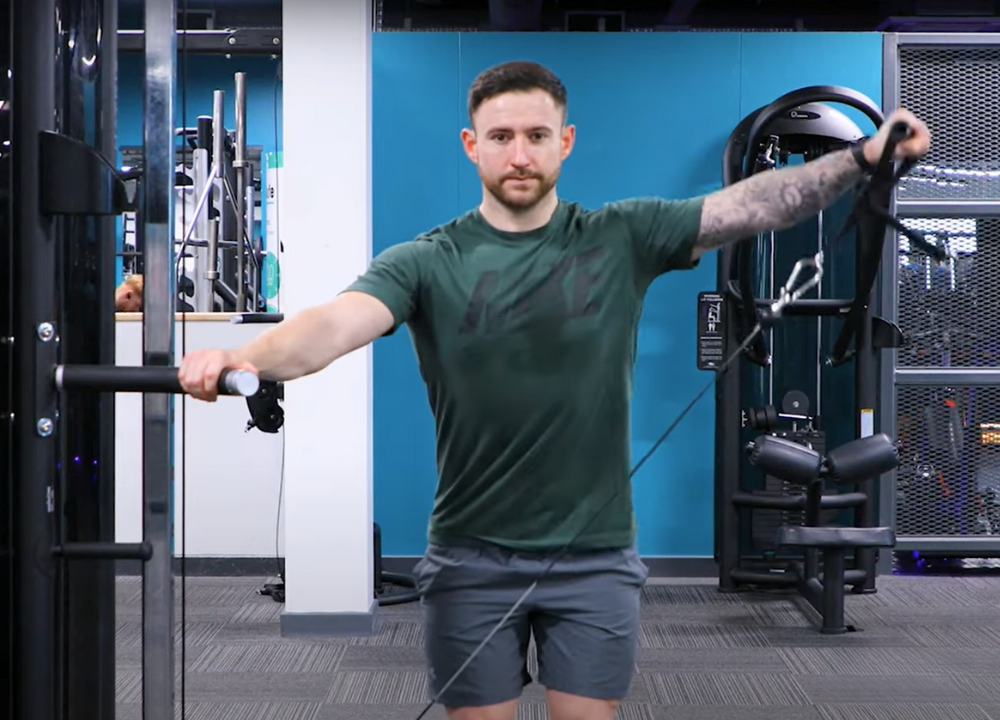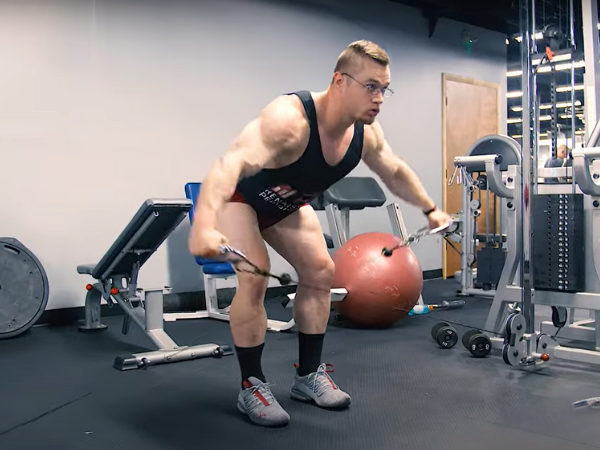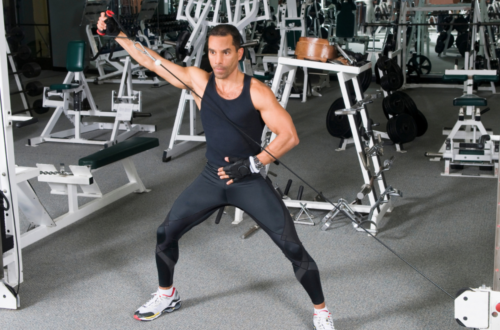
Are Cable Lateral Raises Better Than Dumbbells? Pros and Cons
Cable lateral raises can offer more consistent tension throughout the movement. Dumbbells provide greater freedom of movement and convenience.
Cable lateral raises and dumbbell lateral raises are popular exercises for shoulder development. Each method has its own set of advantages and disadvantages. Cables can maintain constant tension on the muscles, leading to more effective workouts.
Table of Contents
What Are Cable Lateral Raises
Cable lateral raises are a popular exercise for shoulder development. This exercise uses a cable machine to perform lateral raises. It targets the middle deltoid muscle. Cable lateral raises provide constant tension throughout the movement.
How Cable Lateral Raises Differ From Other Shoulder Exercises
Cable lateral raises stand out from other shoulder exercises in several ways:
- Constant Tension: The cable provides continuous resistance. This differs from dumbbells, which only offer peak tension at specific points.
- Range of Motion: The cable allows a smooth and controlled range of motion. This reduces the risk of jerky movements.
- Muscle Isolation: Cable lateral raises isolate the middle deltoid more effectively. This improves muscle activation.
Other shoulder exercises often involve multiple muscles. For example, the overhead press works the entire shoulder complex. Cable lateral raises specifically target the middle deltoid. This makes them ideal for isolating this muscle.
Here’s a comparison table:
| Exercise | Muscles Targeted | Resistance Type |
|---|---|---|
| Cable Lateral Raises | Middle Deltoid | Constant Tension |
| Dumbbell Lateral Raises | Middle Deltoid | Variable Tension |
| Overhead Press | Entire Shoulder Complex | Variable Tension |
Is Cable Lateral Raise A Push Or Pull Movement
Cable lateral raises are considered a pull movement. This is because the exercise involves pulling the cable away from the body.
In a pull movement, the focus is on the muscles contracting to bring the weight towards the body or move it away from the body. In cable lateral raises, the middle deltoid contracts to lift the arm and the cable.
Most shoulder exercises can be classified as either push or pull movements:
- Push Movements: These include exercises like the shoulder press. They involve pushing the weight away from the body.
- Pull Movements: These include exercises like lateral raises and upright rows. They involve pulling the weight or resistance.
Understanding the movement type helps in designing a balanced workout routine. Including both push and pull movements ensures all muscle groups are targeted effectively.

What Muscle Does Cable Lateral Raise Work
The primary muscle worked during a cable lateral raise is the middle deltoid.
Other muscles also play a supporting role:
- Trapezius: Stabilizes the shoulder blades.
- Supraspinatus: Assists in the initial movement of lifting the arm.
- Core Muscles: Maintain stability and posture during the exercise.
Focusing on the middle deltoid helps in achieving broad, rounded shoulders. This muscle is crucial for a balanced and aesthetic upper body.
Here is a simple breakdown:
| Muscle | Role |
|---|---|
| Middle Deltoid | Primary mover |
| Trapezius | Stabilizer |
| Supraspinatus | Assistant |
| Core Muscles | Stabilizer |
Are Cable Lateral Raises Better Than Dumbbells?
Choosing between cable lateral raises and dumbbell lateral raises can be tricky. Both exercises target your shoulder muscles, but they have unique advantages.
Key Differences Between Cable And Dumbbell Lateral Raises
Cable lateral raises and dumbbell lateral raises differ in several key ways:
- Resistance Curve: Cables provide constant tension throughout the movement, while dumbbells offer varying resistance.
- Range of Motion: Cables allow for a more natural range of motion, reducing the risk of injury.
- Muscle Activation: Cables can engage more stabilizing muscles compared to dumbbells.
Here’s a comparison table to highlight the differences:
| Aspect | Cable Lateral Raises | Dumbbell Lateral Raises |
|---|---|---|
| Resistance | Constant | Variable |
| Range of Motion | Natural | Limited by gravity |
| Muscle Activation | Higher stabilizer engagement | Primary muscle focus |
Why Choose Cables Over Dumbbells?
Choosing cables for lateral raises can offer several benefits:
- Constant Tension: Cables keep your muscles under continuous tension. This can lead to better muscle growth.
- Versatility: Cables offer various angles and positions, making them more versatile than dumbbells.
- Safety: The natural range of motion with cables reduces the risk of shoulder injuries.
Cables also allow for more controlled movements. This control can be crucial for beginners. They can focus on form and technique without worrying about balance. Additionally, advanced lifters can benefit from the continuous tension and muscle engagement. This can lead to better muscle hypertrophy and strength gains.
Ultimately, cables can provide a more effective and safer option for lateral raises compared to dumbbells.
Benefits Of Cable Lateral Raises Over Dumbbells
Understanding the benefits of cable lateral raises over dumbbells can help you make an informed decision.
Constant Muscle Tension For Better Gains
One major advantage of cable lateral raises is the continuous tension they provide throughout the entire range of motion. Unlike dumbbells, where resistance changes based on gravity, cables keep muscles engaged from start to finish, leading to improved muscle endurance and better hypertrophy.
Key points:
- Continuous resistance: Cables maintain tension throughout the movement.
- Improved endurance: Constant tension helps in building stamina over time.
- Optimal muscle growth: Consistent engagement can lead to greater muscle development.

Greater Range Of Motion And Muscle Activation
Cable lateral raises allow for a broader range of motion compared to dumbbells, which are limited by body mechanics and gravity. This extended range promotes better flexibility and deeper muscle fiber engagement, targeting the lateral delts more effectively while also activating stabilizing muscles.
Key points:
- Enhanced flexibility: Cables enable full range shoulder movement, boosting flexibility.
- Comprehensive activation: A wider range ensures more muscle fibers are recruited.
- Better stability: Engages stabilizing muscles for a more balanced shoulder workout.
Improved Shoulder Stability And Injury Prevention
Cable lateral raises offer a more controlled and stable movement compared to dumbbells, which can be prone to uneven lifting. The constant tension from cables ensures that your shoulders remain engaged in a balanced way, reducing the risk of injury and promoting long-term shoulder health.
Key points:
- Enhanced stability: Cables follow a fixed path, preventing unwanted wobbling or jerking.
- Injury prevention: The controlled resistance reduces strain on joints, lowering the risk of shoulder injuries.
- Smooth motion: Cables allow for a steady, fluid movement that minimizes sudden, risky motions.
Disadvantages Of Cable Lateral Raises
While cable lateral raises offer unique benefits, they also come with certain disadvantages.
Limited Equipment Availability
One major downside of cable lateral raises is the limited equipment availability. Many gyms have a limited number of cable machines, leading to longer wait times. Unlike dumbbells, which are usually abundant, cable machines are often in high demand.
Home gyms often lack cable machines due to their cost and size. This makes dumbbells a more practical choice for home workouts. The need for specific equipment can limit your training options and flexibility.
Learning Curve: Why Cable Raises Require More Practice
Cable lateral raises come with a steeper learning curve. The technique can be difficult for beginners to master. Unlike dumbbells, which are straightforward, cables require precise movement patterns.
Some common mistakes include:
- Incorrect posture
- Improper cable attachment height
- Poor range of motion
These mistakes can reduce the effectiveness of the exercise and increase the risk of injury. Proper form requires more practice and possibly even guidance from a trainer.
Below is a list of tips to improve your form:
- Start with lighter weights
- Focus on slow, controlled movements
- Keep your core engaged
- Seek feedback from experienced lifters
Mastering cable lateral raises takes time and effort, making them less user-friendly for those new to weight training.
Less Versatility Compared To Dumbbells
Another drawback of cable lateral raises is their lack of versatility compared to dumbbells. Dumbbells can be used for a wide range of exercises, targeting various muscle groups. Cables are more specialized and less adaptable.
Dumbbells offer the following advantages in versatility:
- Can be used for both upper and lower body exercises
- Suitable for compound movements
- Easy to integrate into different workout routines
With cables, you are often limited to specific exercises. This can make your workouts less varied and more monotonous. Below is a comparison of the versatility:
| Equipment | Versatility |
|---|---|
| Cable Machines | Limited |
| Dumbbells | High |
This lack of versatility can be a significant drawback for those looking for a well-rounded training regimen. Dumbbells allow for more creativity and adaptability in your workouts.
Benefits Of Dumbbell Lateral Raises Over Cables
This section explores the Benefits of Dumbbell Lateral Raises Over Cables.

Portability And Accessibility: Dumbbells At Home And Gym
Dumbbells are incredibly portable and accessible. Unlike cable machines, which are bulky and fixed, dumbbells can be used anywhere. Whether you are at home, at the gym, or traveling, you can always carry a pair of dumbbells.
- Home Workouts: Dumbbells are perfect for home workouts. They don’t take up much space and are easy to store.
- Gym Availability: Gyms always have dumbbells. You won’t have to wait in line to use them, unlike cable machines.
- Travel-Friendly: Adjustable dumbbells can be packed in your luggage. Stay fit on the go!
Here’s a quick comparison table:
| Criteria | Dumbbells | Cable Machines |
|---|---|---|
| Portability | High | Low |
| Space Required | Minimal | Large |
| Accessibility | Anywhere | Gym Only |
Natural Shoulder Motion With Free Weights
Dumbbells allow for a more natural shoulder motion. Using free weights, your body moves naturally without constraints. This promotes better muscle activation and reduces the risk of injury.
Here’s why free weights are better for natural shoulder motion:
- Freedom of Movement: Dumbbells allow you to move in multiple planes. This mimics real-life movements and engages more muscle fibers.
- Correct Form: With dumbbells, you can focus on maintaining the correct form. This ensures balanced development and prevents muscle imbalances.
- Injury Prevention: Using free weights reduces the risk of joint injuries. Your muscles and joints move as they naturally should, promoting joint health.
Overall, free weights offer a more holistic approach to shoulder training. You engage stabilizer muscles, improve coordination, and build functional strength.
Easier Progression With Dumbbells For Beginners
Beginners find it easier to progress with dumbbells. Free weights offer a straightforward way to track and increase resistance.
Here are some reasons why dumbbells are ideal for beginners:
- Simple to Use: No complex setup is required. Pick up the weights and start exercising.
- Incremental Weight Increase: Dumbbells come in small weight increments. This allows for gradual progression, which is ideal for beginners.
- Feedback and Learning: Using dumbbells gives immediate feedback on form and balance. Beginners learn faster and can correct their form more easily.
Consider this comparison:
| Criteria | Dumbbells | Cable Machines |
|---|---|---|
| Ease of Use | High | Moderate |
| Weight Progression | Incremental | Fixed Plates |
| Learning Curve | Low | Moderate |
Dumbbells provide a user-friendly approach to resistance training. Beginners can see progress quickly and stay motivated.
Step By Step Instructions: How To Do A Cable Lateral Raise
Learn how to perform the cable lateral raise with perfect form to effectively target your shoulder muscles.
Setting Up The Cable Machine For Optimal Performance
To achieve the best results with cable lateral raises, setting up the cable machine correctly is crucial. Follow these steps to ensure optimal performance:
- Adjust the Pulley Height: Set the pulley at the lowest position. This ensures the cable is at the right angle for your lateral raise.
- Select the Right Handle: Use a single handle attachment. This allows for a firm grip and better control.
- Choose the Appropriate Weight: Start with a light weight. Gradually increase it as you become more comfortable with the exercise.
Here’s a quick setup guide:
| Step | Action |
|---|---|
| 1 | Adjust the pulley to the lowest setting. |
| 2 | Attach a single handle to the cable. |
| 3 | Set the desired weight on the machine. |
Stand with your side to the machine. This ensures you’re in the correct starting position.
Grip the handle with your outside hand. Keep your arm straight and your feet shoulder-width apart.
Mastering The Proper Form For Cable Lateral Raises
Proper form is essential for maximizing the benefits of cable lateral raises. Follow these steps:
- Stand Tall: Keep your back straight and core engaged.
- Initiate the Movement: Lift the handle away from your body.
- Raise Your Arm: Bring it to shoulder height. Keep a slight bend in your elbow.
- Pause: Hold the position briefly at the top.
- Lower Slowly: Return to the starting position in a controlled manner.
Here’s a detailed breakdown:
- Engage Your Core: This helps maintain stability and balance.
- Keep Your Back Straight: Avoid leaning forward or backward.
- Maintain a Slight Bend in Your Elbow: This prevents strain on your joints.
- Control the Movement: Avoid swinging or using momentum.
Remember, consistency and control are key. Practice these steps to master the cable lateral raise.




